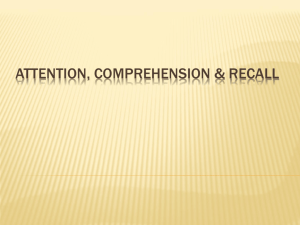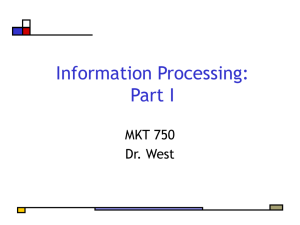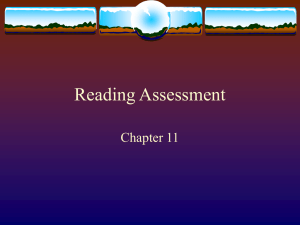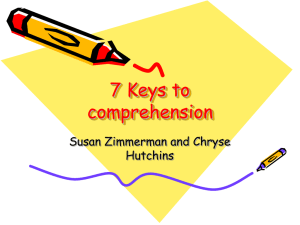Attention and Comprehension
advertisement
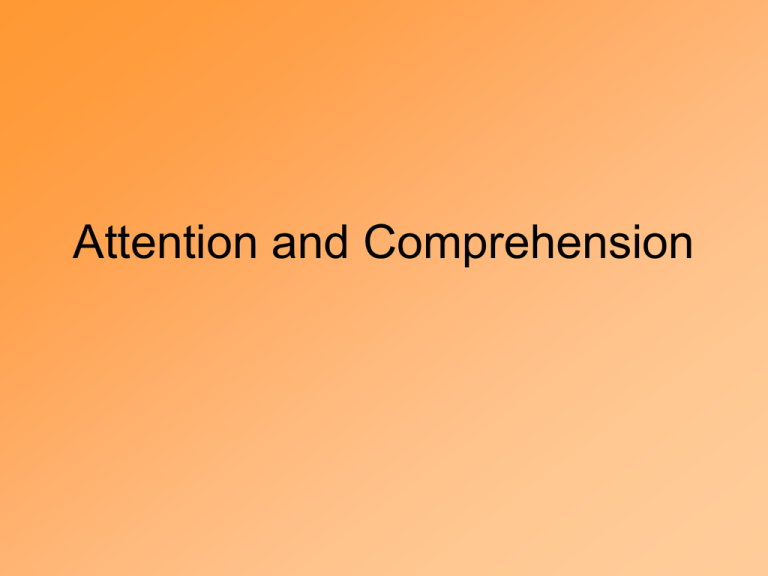
Attention and Comprehension What is perception? It is the process where an individual receives stimuli through the various senses and interprets them The Perception Process Attention Stimulus Interpretation Active Search Simplify Passive search Distort Passive Attention Organize Stimulus Conditions Intensity Size Message Novelty Position Context Audience Conditions Attitudes Values Interests Confidence Social Context Cognitive Style Cognition Getting Attention • The first step in getting your ad noticed by the target segment • Advertising clutter • Noise clutter • Memory is less when viewed/heard with competitive brand advertising. Zipping and Zapping • Zipping is going ‘fast forward’ • Zapping is changing channels or channel surfing How to minimise Zipping and Zapping? Zipping • To get the commercial at the beginning of the pod • Visual elements that would be visible in the main body of the program or even when doing FF. Zapping • Improving ‘likability’ of the ad • Making it interesting and involving Primacy and Recency effects Primacy • Being the first ad, it registers in the mind. Recency • The last one is fresh in memory Therefore such ad positions are priced at a premium. What ads attracts attention? • Product information that would help purchase decision • Those that expose themselves to information that support these opinions and avoid discrepant information • Those that desire to get exposed to information that stimulates • Stimuli which is interesting Information of Practical value The behavioural tendency to process information depends on • Need for information • Expectancy (Probability) that processing a particular ad will lead to relevant information exposure • Measure of the value of that particular as a source of relevant information Long copy Vs short copy • Readership drops sharply after 50 words but between 50 and 500 words there is hardly any difference. • ‘The more you tell the more you sell’ • ‘If you don’t have anything to say, then sing it.’ • Depends on whether it is under active search or for future reference • Infomercials • Advertorials Information that supports • Dissonance theory – Cognitive dissonance is discomforting and people will try to reduce it. One mechanism is through selective exposure • People tend to have a psychological preference for supportive information and avoid discrepant information. This is called selective exposure • Ad awareness seems to be higher for those who already have higher brand attitudes – Rajeev Batra and Wilried Vanhonacker • Involuntary exposure to non-supportive information shall increase selective exposure to information that supports Information that interests • People tend to notice information that is interesting to them – Russel Haley • This where customer self-selection works when such ads are put in mass media. Information that stimulates • Variety theory by Salvadore Maddi. This states that novelty, unexpectedness, change and complexity are pursued because they are inherently satisfying. • Adaptation level theory by H. Helson. People learn to associate stimuli with a reference point or adaptation level. Marked deviation from it shall attract attention. Weber’s Law The degree to which a stimulus would be regarded as different will depend not on the absolute stimulus change but on the% change from some point of reference. I I K Attention vs Recall Recall of an ad is a necessary but not sufficient condition for persuasion. • Ad repetition, higher frequency and higher SOV • Using distinctive creative material in the ad • Merchandising using clues to recall ad at the store Attention vs Comprehension • While getting attention is important it should not detract the viewer from the message • The execution, models, props, etc. must not take precedence over the brand. • Persuasion takes place when good comprehension takes place. Processing would take central or peripheral routes of processing depending on the comprehension. Interpretation vs Comprehension • Objective comprehension What is the take-out of the brand? – copy test scales • Subjective comprehension Explicit – the ad story Implicit – using the ad information along with knowledge and experience already stored in memory The deeper the level of subjective comprehension, the more effective the ad will be credibility, likeability, persuasive and recall – David Mick Perceptual organization • People tend to see objects as a whole than see individually its parts. – S. E. Asch • First impressions are important. • Closure • Assimilation – Contrast • Miscomprehension Brand Attitudes • Cognitive (awareness, comprehension, knowledge) • Affective (evaluation, liking, preference) • Conative (purchase, trial) Attitudes decay over time. Therefore +ve attitudes need to be nurtured and sustained. Attitudes can be examined at three levels • Physical • Pseudo-physical • Benefits –physical and psychological % of total market Attitude Segments 4 3 Competitive efforts1 -ve Marketing efforts 5 2 6 Attitude 7 +ve Ad attitudes • Attitude towards an ad (liking) provided an impact on brand attitudes over and above the ability of the ad to communicate attribute information – Andrew Mitchell, Jerry Olsen and Terence Shrimp • Ad disliking has a greater effect than ad liking. The effect of ad liking are more important for mood ads than for hard-sell ads – McCollum and Spielman What makes an ad more likeable? • • • • Credibility Positive, likeable feelings Uses humour Uses relevant executional devices • Uses relevant, likeable celebrities • Uses endorsers relevant to target market • For a brand already liked • Contains useful information • Interesting and reasonably complex • Contains information that is itself liked (SP) • Placed in a media environment that is itself liked
